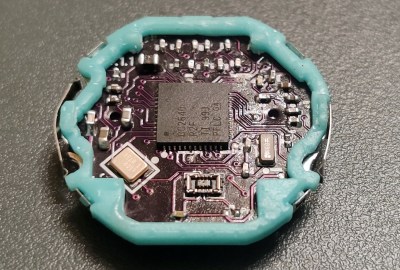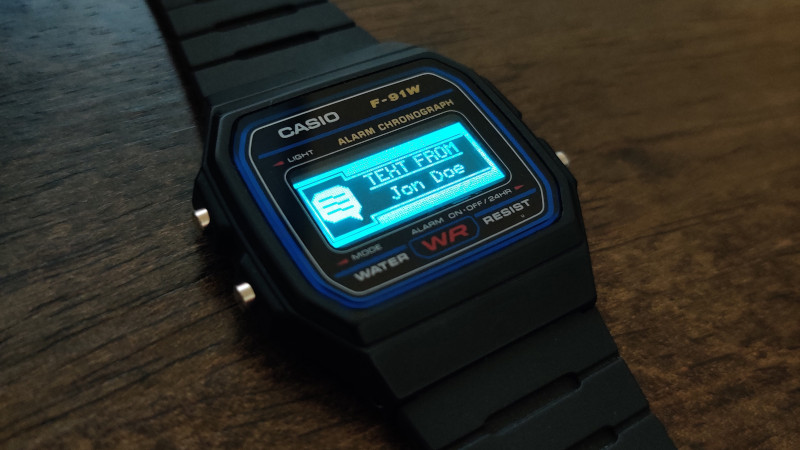In a way, you have to feel a bit sorry for the engineers at Casio. They can produce the most advanced digital watches ever to grace the wrist, but their work will forever be associated with one of their more lowly creations. The Casio F91 is the archetypal digital watch — it’s affordable, it’s been in production since the Ark, it does the job so well that it’s become a design classic, and it remains a very tough act to follow.
 If it has a flaw though, it’s that the functions of a watch from 1989 are very basic. Wouldn’t it be nice if a Casio F91 could be a modern smartwatch! Well thanks to [Pegor] it can, with a complete re-engineering of the classic watch’s internals. Now the simple classic timepiece is fully up-to-date!
If it has a flaw though, it’s that the functions of a watch from 1989 are very basic. Wouldn’t it be nice if a Casio F91 could be a modern smartwatch! Well thanks to [Pegor] it can, with a complete re-engineering of the classic watch’s internals. Now the simple classic timepiece is fully up-to-date!
All the Casio internals are removed, and a new movement holder supports a fresh PCB with an OLED display mounted via a flexible sub-PCB. The brains comes courtesy of a Texas Instruments CC2640 BLE microcontroller. This gives it a 15-day battery life, which is nothing like what the original watch would have but compares favorably to smartwatches. He admits that the software needs some work, but with hardware this well-executed we hope that others can contribute some improvements.
This is probably the most impressive F91 hack we’ve seen, but it’s by no means the first revamped Casio we’ve shown you.
















Looks brilliant, what a great project.
Is it still water resistant? If so … https://tenor.com/view/shut-up-and-take-my-money-futurama-fry-take-my-money-money-gif-15195954
Keeps the original case, so should be…
It’s a very nice job.
I might actually use something like this. I think this sort of category (smartwatches without overly high-powered application processors and bright multicolor displays) used to be commercially available, but isn’t really now. One nice feature would be a memory LCD display instead of the OLED though, so it can be seen in bright conditions more easily.
I think a custom e-paper display would be a better fit. The wireless connection itself needs to be dialed waaay back to improve battery life. I don’t know everything about BLE but I see no reason for this to ever transmit once it’s paired.
this is not such big issue with BLE, you can e.g. have thermometer advertising temperature every second lasting a year from CR2032 cell. But yes, when used more heavily, it can last only few months.
BLE reception takes up about as much power as transmission, and you need to keep the receiver on a bit longer to have long enough window to detect a packet. And the BLE protocol also does require handshake at regular intervals.
The refresh rate is bad, and I personally like having a “seconds” display.
It is possible on some epd’s to do partial refreshes if you are willing to play around with custom LUT’s and sacrifice contrast, then just do a full refresh every once and awhile to prevent damage to the display. But in the case of low power displays that need more frequent updates, I’d opt for a sharp memory lcd over an epd in that case.
AFAIK the display will not be damaged with longer periods between refresh, only the image. It looses contrast and can becom distorted. But with the next refresh everything should be back to normal.
I have a BLE capable pacemaker embedded in my chest. It last reported 12 years of battery life remaining. The protocol isn’t publicly documented and is hopefully encrypted, but I seem to transmit 5 broadcast packets once a minute. The BLE function is a trivial amount of its energy budget. It measures every single atrial and ventricle beat my heart takes, logging statistics and saving detailed reports of anomalous readings.
You’ve basically just described the Pebble, the greatest smartwatch ever 😥
Also Amazfit BIP or Bangle.JS 2 (which is ultimately hackable).
I’m very aware of them, but they aren’t sold any more.
The amazfit bip lite is hckeable, if you get the key by using a Python script. I know it because I have one. Check the project Gadget ridge.
How does this affect the fact you can not buy a new one easily?
The PineTime is relatively low powered too and hackable.
And might take several months to get to you! At least that was my experience buying a Pinecil from them. I love it but I probably won’t buy anything else from Pine.
Customer service is also unfortunately lacking. I’ve had an open ticket for nearly 12 months due to an issue with my Pinebook Pro (I did initially seek help in the community forums before opening a ticket, but wasn’t able to resolve the issue). They asked for my order number and then just stopped responding after I provided it. I have poked them a few times with no luck.
My amazfit gtr is not very smart. But it’s battery stamina is unheard off. 15 days are passed with ease
That Casio is how cockroaches will be telling the time after the nuclear war. So reliable, absurd battery life (I’ve got one still running and I’m sure I’ve not changed the battery in over 10 years). Very let down by the strap though, which inevitably breaks long before the watch.
Neat hack, though echo the comments about an e-paper display.
However, what finally got me to wear a watch after over a decade of not wearing one was the Heath features on the apple “watch”. Scare quotes because it’s basically a health monitor that happens to tell the time. Much as smart phones are computers that can also occasionally make phone calls.
Pretty cool hack, but Casio’s actually beat them to the punch already. Their GMB-200 models have semi-smartwatch features with step tracking and notifications. They manage to get 2 years of battery life out of the coin cell as well, even with bluetooth.
Yeah, but that’s a G-Shock. Very different look and feel to the classic F91. And it’s mostly just “health” features.
Love it!
Love this watch! What a great project
my literal dream watch is like this, but with the classic split silver calculator watch.